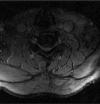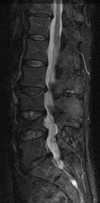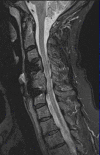Relief of Lumbar Symptoms After Cervical Decompression in Patients with Tandem Spinal Stenosis Presenting with Primarily Lumbar Pain
- PMID: 28123921
- PMCID: PMC5262435
- DOI: 10.7759/cureus.940
Relief of Lumbar Symptoms After Cervical Decompression in Patients with Tandem Spinal Stenosis Presenting with Primarily Lumbar Pain
Abstract
Objective: Tandem cervical and lumbar spinal stenosis (TSS) is classically described as intermittent claudication, gait disturbance, and clinical findings of mixed myelopathy and polyradiculopathy. Rarely, patients can present with TSS manifesting in isolated lumbar pain. Several reports have demonstrated improved lumbar back pain and radiculopathy after decompressive cervical spine procedures. We present six patients with dramatic resolution of lumbar spine related symptoms after decompression of the cervical spinal cord despite presenting solely with lower back complaints.
Methods: Clinical records of the senior author (F.A.S.) gathered from April 2006 to March 2013 were retrospectively reviewed identifying six patients presenting solely with lumbar symptoms and diagnosed with TSS based on history and physical examination.
Results: Six patients with a mean age of 55 (range 39 to 60) presented with solely lower back symptoms and clinical findings suspicious for TSS. Mean follow-up time for all patients was 12 months (range three to 27 months, median 11.5 months). Three patients underwent a cervical procedure as the principal operation, while the remainder had the lumbar spine decompressed initially. All patients that underwent a cervical procedure initially experienced a dramatic decrease or complete resolution of their preoperative lower back pain and radiculopathy (mean preoperative VAS of 6.7 vs. 3.7 postoperative). The remainder of patients with persistent lumbar symptoms resolved after a subsequent cervical operation.
Conclusion: Patients presenting with lumbar symptoms out of proportion to imaging require further investigation. We highlight the resolution of lumbar symptoms after a cervical procedure in a select group of patients presenting with lone lower back complaints. In patients presenting with symptoms disproportionate to lumbar imaging, treatment of cervical pathology may provide robust long-term relief of the initial lumbar-related presentation.
Keywords: cervical myelopathy; cervical stenosis; lumbar stenosis; spine; tandem spinal stenosis.
Conflict of interest statement
The authors have declared that no competing interests exist.
Figures





Similar articles
-
Development of a comprehensive treatment algorithm for tandem spinal stenosis: decision making and surgical strategy.Spine J. 2025 May 8:S1529-9430(25)00248-7. doi: 10.1016/j.spinee.2025.05.021. Online ahead of print. Spine J. 2025. PMID: 40348283
-
Stability-preserving decompression in degenerative versus congenital spinal stenosis: demographic patterns and patient outcomes.Spine J. 2017 Oct;17(10):1420-1425. doi: 10.1016/j.spinee.2017.04.031. Epub 2017 Apr 26. Spine J. 2017. PMID: 28456675
-
Cervical spine surgery for tandem spinal stenosis: The impact on low back pain.Clin Neurol Neurosurg. 2018 Mar;166:50-53. doi: 10.1016/j.clineuro.2018.01.024. Clin Neurol Neurosurg. 2018. PMID: 29408772
-
Spinal stenosis.Handb Clin Neurol. 2014;119:541-9. doi: 10.1016/B978-0-7020-4086-3.00035-7. Handb Clin Neurol. 2014. PMID: 24365318 Review.
-
Management of asymptomatic cervical spinal stenosis in the setting of symptomatic tandem lumbar stenosis: a review.Clin Neurol Neurosurg. 2014 Sep;124:114-8. doi: 10.1016/j.clineuro.2014.06.012. Epub 2014 Jul 2. Clin Neurol Neurosurg. 2014. PMID: 25036872 Review.
Cited by
-
Simultaneous or Staged Decompressions for Patients with Tandem Spinal Stenosis.Orthop Surg. 2021 Jun;13(4):1149-1158. doi: 10.1111/os.12906. Epub 2021 May 4. Orthop Surg. 2021. PMID: 33942985 Free PMC article.
-
Radiographic predictors for recurrence of lumbar symptoms after prioritized cervical surgery in patients with tandem spinal stenosis.Eur Spine J. 2022 Oct;31(10):2769-2776. doi: 10.1007/s00586-022-07295-8. Epub 2022 Jul 11. Eur Spine J. 2022. PMID: 35819541
-
Current understanding of tandem spinal stenosis: epidemiology, diagnosis, and surgical strategy.EFORT Open Rev. 2022 Aug 4;7(8):587-598. doi: 10.1530/EOR-22-0016. EFORT Open Rev. 2022. PMID: 35924651 Free PMC article. Review.
-
Is cervical instability the cause of lumbar canal stenosis?J Craniovertebr Junction Spine. 2019 Jan-Mar;10(1):19-23. doi: 10.4103/jcvjs.JCVJS_17_19. J Craniovertebr Junction Spine. 2019. PMID: 31000975 Free PMC article.
-
Primary cervical decompression surgery may improve lumbar symptoms in patients with tandem spinal stenosis.Eur Spine J. 2021 Apr;30(4):899-906. doi: 10.1007/s00586-020-06693-0. Epub 2021 Jan 6. Eur Spine J. 2021. PMID: 33409728
References
-
- Treatment approach in tandem (concurrent) cervical and lumbar spinal stenosis. Aydogan M, Ozturk C, Mirzanli C, Karatoprak O, Tezer M, Hamzaoglu A. http://www.ncbi.nlm.nih.gov/pubmed/?term=17515237. Acta Orthop Belg. 2007;73:234–237. - PubMed
-
- Iliopsoas weakness: a clinical sign of lumbar spinal stenosis. LaBan M. http:////journals.lww.com/ajpmr/Fulltext/2004/03000/Iliopsoas_Weakness__... Am J Phys Med. 2004;83:224–225. - PubMed
-
- Combined cervical and lumbar spondylosis. Teng P, Papatheodorou C. Arch Neurol. 1964;10:298–308. - PubMed
-
- Coexisting cervical and lumbar spinal stenosis: diagnosis and management. Epstein NE, Epstein JA, Carras R, Murthy VS, Hyman RA. http:////journals.lww.com/neurosurgery/abstract/1984/10000/coexisting_ce.... Neurosurgery. 1984;15:489–496. - PubMed
-
- Coexisting cervical spondylotic myelopathy and bilateral carpal tunnel syndromes. Epstein NE, Epstein JA, Carras R. http://www.ncbi.nlm.nih.gov/pubmed/2562443. J Spinal Disord. 1989;2:36–42. - PubMed
LinkOut - more resources
Full Text Sources
Other Literature Sources
Miscellaneous
